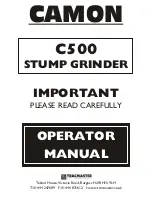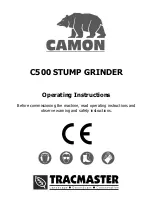
Eterra - Stump Grinder - User Manual - Rev 1.0
Document:
Eterra - Stump Grinder - User Manual - Rev 1.0
11/04/2019
Page 6 of 17
1.5 Operational Safety
• Read and understand the Operator’s Manual and all safety signs before operating, servicing,
adjusting or unplugging.
• Do not allow riders on the Skid Steer during field operation or transport.
• Install and secure all guards and shields before starting and operating.
• Never wear ill-fitting, baggy or frayed clothing when working around or on any of the drive sys-
tem components.
• Keep hands, feet, hair and clothing away from all moving and/or rotating parts.
• Never operate the machine inside a closed building.
• Stop Skid Steer engine, place hydraulic controls in neutral, set park brake, remove ignition key
and wait for all moving parts to stop before servicing, adjusting, repairing or unplugging.
• NEVER EVER Climb out of your machine with the boom raised. Serious injury or death can
occur.
• Ensure that all Skid Steer controls are in neutral before starting.
• Clear the area of all bystanders, especially children, before starting.
• Be careful when working around or maintaining a high-pressure hydraulic system. Wear prop-
er eye and hand protection when searching for a high-pressure leak. Use a piece of wood or
cardboard as a backstop when searching for a pin-hole leak in a hose or line.
• Before applying pressure to the hydraulic system, make sure all components are tight and that
steel lines, hoses and couplings are not damaged.
• Take care when working on steep ground, particularly when turning, and especially with mount-
ed Stump grinders.
• Stay away from overhead obstructions and power lines during set-up and operation. Electrocu-
tion can occur without direct contact.
• Review all safety instructions annually
1.6 Maintenance & Transport Safety
• Review the Operator’s Manual and all related Maintenance, Operating and SAFETY information
annually with all personnel who will be working with, maintaining or operating the Stump grind-
er.
• Be careful when working around or maintaining high-pressure hydraulic systems. Wear prop-
er eye and hand protection when searching for a high-pressure hydraulic leak. Use a piece of
wood or cardboard as a backstop when searching for a pin-hole leak in a hose or steel line. Do
not attempt any makeshift repairs to the hydraulic lines, fittings or hoses by using tape, clamps
or cements. The hydraulic system operates under extremely high-pressure. Such repairs will



































